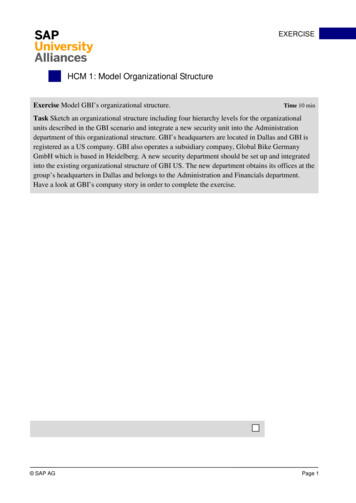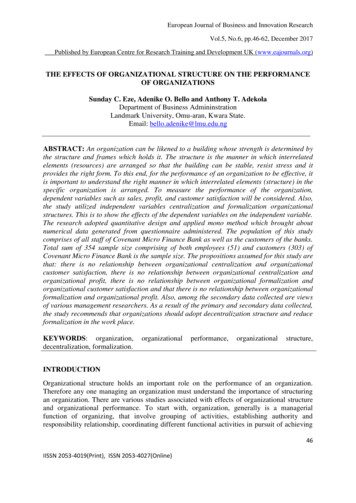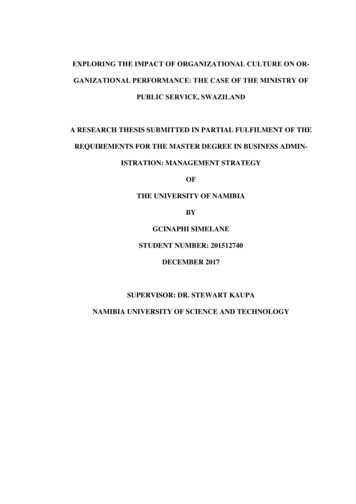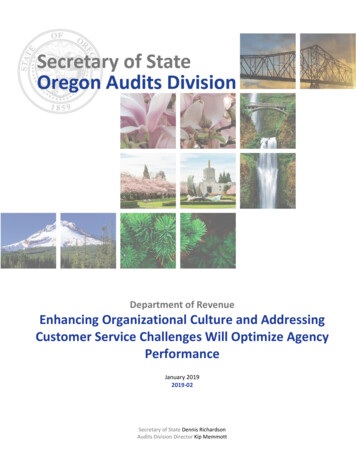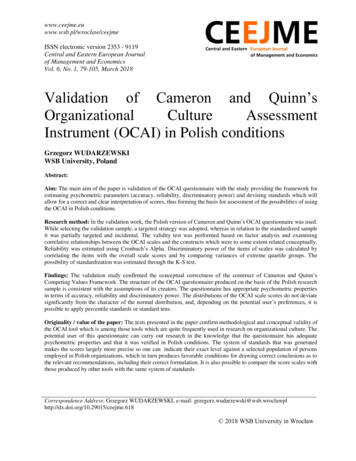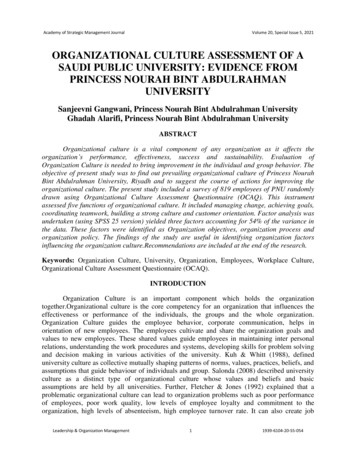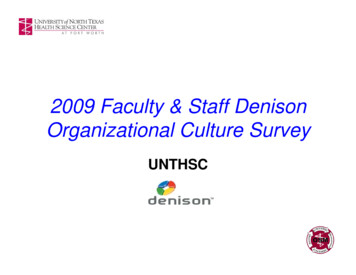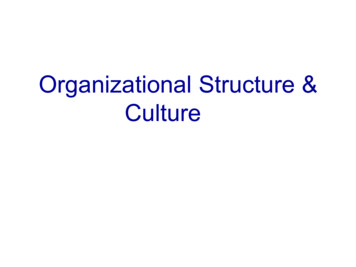
Transcription
Organizational Structure &Culture
Organizational Structure
What is OrganizationalStructure?Defines how job tasks are formally– Divided– Grouped– CoordinatedSix key elements––––––Work specializationDepartmentalizationChain of commandSpan of controlCentralization & decentralizationFormalizationControls, coordinates & motivates employees
Work SpecializationDegree to which tasks in organization aresubdivided into separate jobsEfficiency gains– Payment related to skillskill-level required– Increase in performance in specific task– Encouraging creation of special inventionsEfficiency lossesBoredomFatiguesStressPoor qualityHigh absenteeism & turnoverProductivity–––––specialization
DepartmentalizationThe basis by which jobs are grouped togetherPossible ways– By functions performedE.g., engineering, accounting, personnel .– By type of productE.g., fuel, waxes, chemicals– On basis of geographyE.g., western, southern, midwestern, eastern – On basis of processE.g., Casting, press, tubing, finishing, inspect, pack, ship .– By type of customerE.g., Service retail, wholesale, government customersLarge companies might combine the forms!
The Chain of Command & Span ofControlChain of command– Line of authority from top of the organization to lowest part– Specifies who reports to whom– Each managerial position is given its place & degree ofauthority– Unity of command principle preserves unbroken line ofcommandSpan of Control––––Number of subordinates a manager directsWider spans more efficient in terms of costsWhen span too large, performance suffersSmall spans make communication complex & encourage
Centralization & DecentralizationCentralization– degree to which decision making is concentratedat a single point– Only with respect to formal authorityDecentralization– Degree to which decision discretion lies withlower--level employeeslower– Advantages:More quick in taking actionMore people provide input in decision makingEmployees less likely to feel alienated from decisionmakers
FormalizationDegree to which jobs are standardizedThe more formalized,– The more rules, procedures, job descriptions– The less discretion job incumbent has overWhat is to be doneWhen it is to be doneHow it is to be done– The more consistent & uniform outputDegree of formalization can varybetween & within organizations!
Organization ChartsA pictorial record showing– Formal relations– How the company is supposed to beOrganigraphs (Mintzberg & van der Heyden,1999)– Graphical representations of organizations– Showing the way in which people organize at work– Less formal authority, rather relationships &proacesses
Examples of OrganizationCharts I
Examples of OrganizationCharts IIMatrix Structure
Organigraphs - Examples
Why Do Structures Differ?Contingency approach to organizationstructure: To be effective, organizationmust adjust structure consistent with– The type of environment it works in– The technology it uses– Its size– Its strategy– Other contextual factors
Links Between Strategy &StructureStructure should follow strategy or bothdevelop together?Strategic choices– Innovation strategy (“prospector”) - organicstructure, flexible structure– Cost minimization strategy (“defender”) - mechanistic structure– Imitation strategy (“analyzer) - mechanistic& organic; matrix structures
Strategic Choice &EnvironmentsDecisions about structure are based onpersonal beliefs & political decisions bysenior managersEvidence for this– In same environments, firms with differentstructures successful– Managers can create their own environments– Environments can be perceived differently– Political factors coco-determine structural choices
Links of Structures With EmployeePerformance & SatisfactionSpecialization – higher productivity & less satisfaction– But: Individual differences & differences in types of task!– The higher educated, the less satisfaction from specialized jobNo supported relationship between span of control andperformance– Some people like to work alone– Some people prefer security of boss available– ManagerManager s satisfaction increases with number of subordinatesCentralization linked with job satisfaction– Less centralized organizations – more participatory decisionmaking – more satisfaction– Again dependent on individual characteristics
Organizational Culture
The ConceptDefinitions (!)– H & B: “.the collection of relatively uniform & enduring values,beliefs, customs, traditions & practices that are shared by anorganization s members, learned by new recruits, & transmittedorganizationfrom one generation of employees to the next.”– Robbins: “A common perception held by the organization organization smembers; a system of shared meaning.”– Greenberg & Baron: “A cognitive framework consisting of attitudes,values, behavioral norms, & expectations, shared by organizationmembers.Basic idea:– Organizations have “something” giving them a unique identity.Development– Popular concept since the early 1980s.– Interdisciplinary.– Controversial concept!
The Controversy AboutOrganizational CultureManagement literature likes the concept– Managers supposed to be able to influence theculture of the company– Strength of culture has influence on effectiveness ofan organizationAcademic critics state that the concept is of nouseAcademic supporters disagree about– Concept itself– Importance as explanatory tool“Dark side” of the concept - manipulative
Organizational CultureEdgar Schein Schein s model of culture– One of the most known concepts– Three levels, distinguished byVisibilityAccessibilityThe three levels– Surface manifestations– Values– Basic assumptions
Surface ManifestationsMost visible & accessible formsVisible & audible behaviour patterns & objects– Visible to employees, customers, visitors!Examples– Artefacts & Physical layout (tools, furniture,clothes )– Ceremonials, Rites & Rituals– Courses (introduction, orientation, training)– Myths, Heroes & Stories– Language– Mottoes & Slogans– Norms– Symbols
Amazon.comNike“ Bill Bowerman. Who is he? Legendary track& field coach at the University of Oregon. Ateacher who showed athletes the secrets ofachievement. Co-founder of Nike. Husband,father, mentor. From him we derive our mission.Through his eyes we see our future.”An AmazingTie-Free Zone Casual Intense Fun Different Creative Challenging Frugal Energized Open
ValuesThings that have personal or organizational worthfor founders & senior managers– Based on moral, societal or religious principlesNot visible, but individuals can be aware of them– Most important factor distinguishing organizations– Provide common direction for employees & guidelinesfor behaviourSources– Past experiences– Views of the founderFound in company reports, on websites
MicrosoftDelivering on our mission requires great people who are bright, creative, and energetic,and who share the following values:·Integrity and honesty.·Passion for customers, partners, and technology.·Open and respectful with others and dedicated to making them better.·Willingness to take on big challenges and see them through.·Self-critical, questioning, and committed to personal excellence and selfimprovement.·Accountable for commitments, results, and quality to customers,shareholders, partners, and employees.New Orleans Center for Science and MathIn a district of struggling schools and at-risk kids, thisurban high school is a model of achievement. Thesestudents are not merely learning real-world tech skills,they are realizing dreams they never thought attainable
Basic AssumptionsInvisible, preconscious, “taken“taken-forfor-granted” understandingsHeld by individuals with respect to– Aspects of human behaviour– Nature of reality– OrganizationOrganization s relationship to itsenvironmentDifficult to access
Creating & Sustaining CultureCreating Culture– Founders of an organization– Experience with environment– Contact with othersKeeping a Culture alive– Selection practices– Socialization– Top management actions
What is learning?Definition: “ Learning is the process ofacquiring knowledge through experiencewhich leads to an enduring change inbehavior” (H & B)The result of this process: KnowledgeTwo types of learning:– Procedural learning (learning how)– Declarative learning (learning that)
Behaviourist Vs. CognitiveApproachBehaviourist psychologyCognitivist psychologyStimulus--responseStimulusInformation processingStudies only observable behaviour Studies mental processes as wellBehaviour determined by learnedsequences of muscle movementsBehaviour determined by memory,mental processes, expectationsWe learn habitsWe learn cognitive structures &alternative ways to achieve goalsProblem solving by trial and errorProblem solving involves insight &understanding as well
Behavior Modification OptionsProcedureOperationalizationPositive reinforcementManager compliments employeeeach time work is completed onscheduleNegative reinforcementUnpaid overtime continues to bemandatory until work is completedonschedule, then overtimerewardedPunishmentManager asks employee to staylate when work is not handed inon scheduleExtinctionManager ignores the employeewhen work is handed in late
Application: Socialization andSocial LearningSocialization: “The process through which anindividual s pattern of behaviour, and theirindividualvalues, attitudes and motives, are influenced toconform with those seen as desirable in aparticular organization, society or subsub-culture.”(H&B)Social learning (Bandura)– We learn new behaviours through observing ©ing the behaviour of others– Without rewards or punishments– Still, reinforcement plays a role!
Organizational Socialization“The process through which an individual individual spattern of behaviour, their values, attitudes &motives are influenced to conform with those seenas desirable in a particular organization.” (H & B)New employees learn about the company company sculture– Reduces variability of behavior– Enhances predictabilityIncludes– Selection of new members– Instruction in appropriate ways of thinking & behaving– Reinforcement of desired behaviours
Organizational orphosisCommitmentTurnover
Organizational SocializationCont.Pre--arrival (selection)Pre––––To inform prospective employees about organizationsEnsure that values of firm and recruits fitConveys to those admitted that they are members of an eliteReinforces image of organization to future applicantsEncounter– New recruit learns about organizational expectations– Detached from prior assumptions, replaced by the organization organization sMetamorphosis– Adjustment to organization organization s values– Can be real or fabricated– If not reached, employee might resign
How to Learn a CultureStories– Narratives of events about the founders, rulebreaking, organizational coping– Anchor the present in the past– Provide explanations & legitimacy for currentpracticesRituals– Repetitive sequences of activities– Express & reinforce key values of organization,most important goals & people
How to Learn a Culture Cont.Symbols– Layout of headquarters & offices– Types of automobiles given to executives.– Convey information aboutWho is importantDegree of egalitarianismKinds of behavior appropriateLanguage– Special terminology used to describeEquipmentOfficesKey personnelProducts – Members using this accept the culture & preserve it
Functions of CultureBoundary-definingBoundaryConveys sense of identityFacilitates generation of commitment to aimsabove selfself-interestEnhances social system stabilitySense--making & control mechanismSenseNo clear link between culture & economicperformance found yet
Problems of CultureBarrier to changeBarrier to diversityBarrier to mergers & acquisitions An illustration – an experimental study ofculture
The Link With National CultureParallel discussion: Effect of national/societal cultureon organization cultures– How do national cultures affect organization culturesTrait lists, like in personality research– Example: the US culture:IndividualismPrecise timeValue of work & performanceRespect for diligence .Comparative studies: Example: Hofstede (1984,1986, 1991)
The HofstedeHofstede-StudiesCross-cultural studyCross116 000 employees of 1 multinationalcompanyLocated in 40 countriesAim: identfy basic dimensions ofdifferences between national cultures
The HofstedeHofstede-Studies Cont.Four (five) dimensions–––––Power distanceUncertainty asculinity--femininityMasculinity( longlong-term – shortshort--term orientation)Each dimension represents continuum– Each country can be rated from high to low– Placed somewhere along each continuum
The HofstedeHofstede-Studies Cont.Importance of organization culturaldifferences stemming from societal culturaldifferencesNational & organizational cultures stronglylinkedImportant for– Expatriate management– Cross cultural management– Human resource management in differentcountries
The HofstedeHofstede-Studies Cont.Power distance low:– less centralization– Flatter organization pyramids– Examples: australia, israel, denmark,swedenPower distance high– Greater centralization– Tall organization pyramids– More supervisory personnel– Examples: Mexico, Venezuela, India
The HofstedeHofstede-Studies Cont.Femininity high:–––––Gender roles minimizedMore women in more qulified jobsSoft, yielding, intuitive skills rewardedLife quality importantExamples: Thailand, ScandinaviaMasculinity high– Gender roles clearly differentiated– Fewer women in more qualified jobs– Aggressiveness, competitiveness, decisivenessrewarded– Stress on careers– Examples: Japan, Italy, Mexico
The HofstedeHofstede-Studies Cont.Collectivism high:– Organization as family– Organization defends employee interests– Practices based on loyalty, sense of duty, groupparticipation– Examples: Venezuela, Taiwan, GreeceIndividualism high:––––Organizations more impersonalPractices encourage individual initiativeTask prevails over relationshipsExamples: USA, Britain, Netherlands
The HofstedeHofstede-Studies Cont.Uncertainty avoidance low:–––––Less structuring of activitiesFewer written rulesGreater willingness to take risksTolerance of deviant persons & ideasExamples: Denmark, Britain, USAUncertainty avoidance high:–––––More structuring of activitiesMore written rulesLess willingness to take risksMore ritualistic behaviorExamples: Greece, Portugal, Japan, France
LiteratureH & B chapter 19Robbins chapter 17Greenberg & Baron chapter 14
Contingency approach to organization structure: To be effective, organization must adjust structure consistent with -The type of environment it works in -The technology it uses -Its size . -Some people prefer security of boss available -Manager s satisfaction increases with number of subordinates


